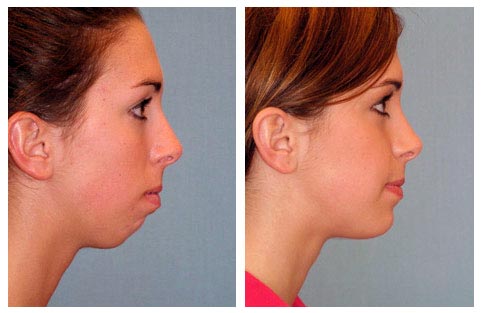chin augmentation And mentoplasty Surgery
Chin Augmentation (Mentoplasty) Basics
During a chin augmentation the chin is reshaped through the use of an implant, an injectable paste, or by changing the shape of the bone. Though most people considering facial plastic surgery are concerned with other areas of their face such as their nose, eyes, and ears, a chin augmentation is often performed to achieve symmetry with other facial features, and is sometimes done in combination with other procedures such as nose surgery. One other distinction that separates chin augmentation from many other cosmetic procedures is that it, along with gynecomastia (male breast reduction) surgery and hair transplants, is one of only three procedures performed more frequently on male patients than on female ones.
How It's Done
Chin augmentation is an outpatient procedure performed under general anesthetic or local anesthetic with sedation. The surgeon begins the procedure by making a small incision under the chin or inside the mouth. Though incisions placed inside the mouth do not create visible scars, the chance of infection is increased, especially if plaque or other oral bacteria is present. Incision placement should be discussed with your doctor before surgery.After the incision, the surgeon stretches the tissue to allow for implant insertion. After the implant, or synthetic paste, is molded into place inside the skin, sutures are used to pull the skin together. If the chin size is being reduced, the surgeon, after making a similar incision, sculpts the bone of the chin to change the appearance. Total surgery can last between 1 and 3 hours.
Technology
Since about 1956 chin implants have been used for augmentation. These days, of course, technology has advanced and there are many different options available: everything from silicone to more porous, flexible, and biocompatible materials. Now there is even a synthetic paste that can be used to mold a new chin. Because there are many different options available you should discuss which type your surgeon prefers and why. For some, the paste is a less appealing option because the form can change for up to two days, while others have had success.Recovery / Post Op Expectations
After surgery patients are required to wear a protective covering over their chin for the first few days. Some bruising and swelling should be expected. There is a relatively small amount of pain, in comparison with other surgeries, but pain medication usually is prescribed. Numbness can last as long as 3 months, and soreness and tenderness can last just as long. Return to work should be expected the week following surgery.Complications
As with any major surgery, there are risks and complications associated with chin augmentations. Infection is always a threat, as is adverse reaction to anesthesia. Procedure specific complications include:- Implant moving, or shifting out of alignment
- Blood clots
- Rejection of implant by body, resulting in necessary removal
Am I A Candidate?
Candidates for surgery should be at least 18 except in instances of medical necessity. Additionally, patients should be well informed and in good physical health. Most patients are unhappy with their appearance due to a weak or asymmetrical chin.Cost
The national average physician's fee for 2003 was reported as $1,693 by the American Society of Plastic Surgeons (ASPS). When anesthesia and other additional charges are included, the total price tag can range from $2,500 to $5,000.A chin augmentation/mentoplasty is a surgical procedure to reshape or enhance the size of the chin. It may be done either by inserting an implant or by moving or reshaping bones.The procedure may be requested by those with a prominent nose or other facial features who wish to create a more proportionate appearance, though the procedure is often used in conjunction with other forms of cosmetic surgery.

Chin augmentation is usually done to balance the face by making the chin longer or bigger compared to the nose. The best candidates for chin augmentation are people with weak or receding chins (microgenia), but who have a normal dental bite.
Before your surgery, discuss your expectations about looking and feeling better with the plastic surgeon. Keep in mind that the desired result is improvement, not perfection.
Chin augmentation is still popular because it’s a relatively easy operation for the patient while producing noticeable changes in the silhouette of the face. This type of surgery is usually performed by a either an oral and maxillofacial surgeon, otolaryngologist, or plastic surgeon.







0 comments:
Post a Comment